1979-1982
(Ray Brandes recounts the history of a San Diego band that should have ruled the airwaves. Excerpted from Ray's book Getting Nowhere Fast.)
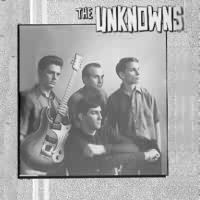 Anyone who had the opportunity to see the Unknowns play had an unforgettable experience. Crisp, staccato drumming and the dripping-wet reverberation of Mosrite guitars through Fender amplifiers was punctuated by the yips and howls of the legendary melodramatic lead singer, Bruce Joyner, who sang from a chair or aided by a cane, looking every bit like a down-home Barnabas Collins in search of fresh blood.
Anyone who had the opportunity to see the Unknowns play had an unforgettable experience. Crisp, staccato drumming and the dripping-wet reverberation of Mosrite guitars through Fender amplifiers was punctuated by the yips and howls of the legendary melodramatic lead singer, Bruce Joyner, who sang from a chair or aided by a cane, looking every bit like a down-home Barnabas Collins in search of fresh blood.
Their tight and powerful act upstaged every band with whom they played, including the Go-Gos, Madness, the Blasters, the Plimsouls, Wall Of Voodoo, the Romantics, Joe King Carrasco, Romeo Void, the Textones, the Suburban Lawns, Missing Persons and scores of others.
At times the band members themselves have lamented that their place amongst their peers seems to have been forgotten over the years, yet they were the first San Diego band signed to a major label since the Iron Butterfly in 1967. They were named one of the top four bands in California by the Los Angeles Times in the early ‘80s. They were the first band from the San Diego scene to perform live on a major syndicated television show, Peter Ivers’ “New Wave Theater,” which was picked up by Armed Forces Television and the USA Network’s “Night Flight.” And their Sire album “Dream Sequence” has sold nearly 100,000 copies to date.
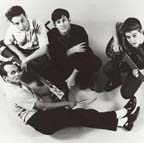 The Unknowns were the product of an unlikely collision between two powerful forces: the brilliantly eccentric Bruce Joyner and the single-minded guitarist and visionary Mark Neill. Their sound emerged from a primordial soup of ‘50s rhythm and blues and rockabilly along with ‘60s and ‘70s proto-punk, country and reggae, and the entire mixture was incubated in the vibrant art scene of Valdosta, Ga., a university town a few miles from the Florida border.
The Unknowns were the product of an unlikely collision between two powerful forces: the brilliantly eccentric Bruce Joyner and the single-minded guitarist and visionary Mark Neill. Their sound emerged from a primordial soup of ‘50s rhythm and blues and rockabilly along with ‘60s and ‘70s proto-punk, country and reggae, and the entire mixture was incubated in the vibrant art scene of Valdosta, Ga., a university town a few miles from the Florida border.
The Unvanquished
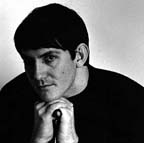 Bruce Joyner was born in Manchester, N.C., in 1952, and his family moved to South Georgia nine months later. His parents divorced, and for months he and his mother lived a meager existence, sleeping in dairy barns, mill houses and windowless shacks from which they had to clear hay before they could rest. Bruce recalls, “Being poor shaped me, seeing other poor people shaped me, and living in the country certainly shaped me. I sing about all these things. I have gone without food because there was none. I lived the stories William Faulkner wrote about — the downside and the upside of southern living.”
Bruce Joyner was born in Manchester, N.C., in 1952, and his family moved to South Georgia nine months later. His parents divorced, and for months he and his mother lived a meager existence, sleeping in dairy barns, mill houses and windowless shacks from which they had to clear hay before they could rest. Bruce recalls, “Being poor shaped me, seeing other poor people shaped me, and living in the country certainly shaped me. I sing about all these things. I have gone without food because there was none. I lived the stories William Faulkner wrote about — the downside and the upside of southern living.”
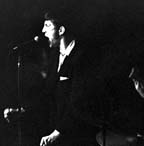 At age four, Bruce suffered the first in a series of unfortunate accidents that would ultimately shape both his personality and his world view. According to Bruce, “The little girl who lived next to us offered me some candy that I swallowed. It was from her dad’s and grandfather’s photography storehouse, where they kept chemicals to process pictures. After a wild ride courtesy of my stepdad, my life was saved, but my vocal cords and stomach lining were scarred.” His mother taught him how to speak again by playing her records — Buddy Holly, Roy Orbison, Elvis, Bill Haley, Hank Williams and many more. For a year and a half Bruce lived and breathed singing: “I stood on a chair and entertained my relatives by singing the songs I learned from those records. I loved their attention and praise and their handclaps. I was hooked. From the age of six I knew I wanted to be a singer, but the only person that encouraged me was my mother and she never saw me sing for an audience except for my relatives. I also learned you can cry and give up, or keep singing through the pain of it all. If you never give up, you never lose.”
At age four, Bruce suffered the first in a series of unfortunate accidents that would ultimately shape both his personality and his world view. According to Bruce, “The little girl who lived next to us offered me some candy that I swallowed. It was from her dad’s and grandfather’s photography storehouse, where they kept chemicals to process pictures. After a wild ride courtesy of my stepdad, my life was saved, but my vocal cords and stomach lining were scarred.” His mother taught him how to speak again by playing her records — Buddy Holly, Roy Orbison, Elvis, Bill Haley, Hank Williams and many more. For a year and a half Bruce lived and breathed singing: “I stood on a chair and entertained my relatives by singing the songs I learned from those records. I loved their attention and praise and their handclaps. I was hooked. From the age of six I knew I wanted to be a singer, but the only person that encouraged me was my mother and she never saw me sing for an audience except for my relatives. I also learned you can cry and give up, or keep singing through the pain of it all. If you never give up, you never lose.”
At the age of six, Bruce lost his right eye. “I was walking home with a group of first graders when older kids started throwing dirt clods and debris at my classmates and me. When I tried to make them stop, one threw the broken top of a coke bottle that cut my right eye in half, leaving part of it on the ground and half hanging out of its socket. For years, I suffered from migraine headaches after my eye was destroyed.”
As Bruce grew up, he immersed himself in both music and literature, and in college nourished himself with the greatest works of art the American South ever produced. “I voraciously read every book I could get my hands on,” Bruce says. “William Faulkner inspired me as a writer, and Sidney Lanier framed poems of the nature of the South and shared my love for the swamps and marshes of South Georgia. Jim Thompson put my thoughts into stories I grew up to live and turn into songs. Poe, Lovecraft, and Baudelaire all spoke to my soul and my pen. As a singer I loved the voice of Roy Orbison, the energy of Gene Vincent, the craziness of Jerry Lee Lewis, and the darkness of the soul that Hank Williams sang about with his voice that seemed to come from somewhere in the night.”
In 1975, the day before final exams during his senior year in college, Bruce was a passenger in a car wreck near Valdosta State College that left him with a permanently damaged spinal cord. There were four people in the car, and Bruce had been seated behind the driver, who ran into a roadside telephone wire box, breaking both of Bruce’s legs, both arms, his ribs and his back. “I became a cripple,” Bruce says. “I don't use the feel-good term ‘handicapped.’ There is nothing handy about being a person with an injured spinal cord but I don't let my injury limit me at all. I have pain in my legs below my knees all the time, but I can tune it out most of the time. I let the pain help me feel the songs I sing.”
He was pronounced dead and tagged after surgery, but “I came back into my body when I saw my mother crying in the hallway during my out-of-body experience,” he reveals. Bruce spent months in convalescence, once again faced with challenges that would have stopped anyone with a more limited view of the world dead in his tracks. After coming out of intensive care, the first music Bruce heard was a tape he had ordered by mail before the wreck: David Bowie’s Diamond Dogs.
Great Balls of Fire
 Although he was born at San Diego’s Mercy Hospital in 1961, Mark Neill’s Southern roots run deep. His father’s side of the family is all from Arkansas, and his mother’s side hails from Texas. For the first few years of his life, Mark grew up with his father in rural El Cajon, Calif., at the end of Broadway, near the legendary Bostonia Ballroom, which at various times played host to Johnny Cash, Patsy Cline and Bill Monroe. In 1967 (“after Sergeant Pepper,” Mark says), his mother remarried, and they moved to Hahira, Ga., a small farming community best known for its annual Honey Bee Festival. According to Mark, “The move was completely random. They wanted to get as far away as possible from an urban environment, but had no idea Hahira was ten miles from Valdosta, Ga., a hip college town that had a thriving music scene.”
Although he was born at San Diego’s Mercy Hospital in 1961, Mark Neill’s Southern roots run deep. His father’s side of the family is all from Arkansas, and his mother’s side hails from Texas. For the first few years of his life, Mark grew up with his father in rural El Cajon, Calif., at the end of Broadway, near the legendary Bostonia Ballroom, which at various times played host to Johnny Cash, Patsy Cline and Bill Monroe. In 1967 (“after Sergeant Pepper,” Mark says), his mother remarried, and they moved to Hahira, Ga., a small farming community best known for its annual Honey Bee Festival. According to Mark, “The move was completely random. They wanted to get as far away as possible from an urban environment, but had no idea Hahira was ten miles from Valdosta, Ga., a hip college town that had a thriving music scene.”
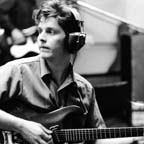 Mark’s earliest memories are centered around music. In the ‘50s, his parents collected R&B 45s, which were the typical fare on labels such as Imperial, Specialty and Deluxe. Some of his favorites were Jimmy Reed’s “Honest I Do”; Lefty Frizzell’s “Saginaw Michigan”; and “Let the Four Winds Blow” by Roy Brown, which he used to play so much that he drove his mother crazy. “Mom collected largely black music,” Mark says, “but the rockabilly she collected was very selective — only ‘56-’57 rockabilly like Carl Perkins, the first wave of rockabilly. So later on, when everyone else was listening to “In-A-Gadda-Da-Vida,” I was collecting Jerry Lee Lewis.”
Mark’s earliest memories are centered around music. In the ‘50s, his parents collected R&B 45s, which were the typical fare on labels such as Imperial, Specialty and Deluxe. Some of his favorites were Jimmy Reed’s “Honest I Do”; Lefty Frizzell’s “Saginaw Michigan”; and “Let the Four Winds Blow” by Roy Brown, which he used to play so much that he drove his mother crazy. “Mom collected largely black music,” Mark says, “but the rockabilly she collected was very selective — only ‘56-’57 rockabilly like Carl Perkins, the first wave of rockabilly. So later on, when everyone else was listening to “In-A-Gadda-Da-Vida,” I was collecting Jerry Lee Lewis.”
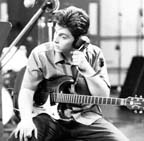 His intense love of music, as well as his esoteric tastes, often put him at odds with his peers. “I remember it like it was yesterday,” Mark says. “Having the old records since toddler age, and having so many of them and having such an affection for them that only kids can have for their stuff, I developed a very unhealthy sentimentality for the music, and the actual sound of the records, which were mono. They were very loud records. It made me, in effect, socially retarded. I founded myself behind the eight ball, socially. I distinctly remember in the early ‘70s, being asked to come to an ice-cream-social type of event, and being asked to bring my favorite records. Everybody else was playing the Partridge Family, and songs like “Seasons in the Sun” by Terry Jacks. I put on a 45 of “Great Balls of Fire” after that, and it blew a hole in the back wall. It was twice as loud as the LPs they were playing! Everyone looked at me like I was a leper — ‘What are you doing? You broke it!’ But to me it was like having a BB gun or an air pistol.”
His intense love of music, as well as his esoteric tastes, often put him at odds with his peers. “I remember it like it was yesterday,” Mark says. “Having the old records since toddler age, and having so many of them and having such an affection for them that only kids can have for their stuff, I developed a very unhealthy sentimentality for the music, and the actual sound of the records, which were mono. They were very loud records. It made me, in effect, socially retarded. I founded myself behind the eight ball, socially. I distinctly remember in the early ‘70s, being asked to come to an ice-cream-social type of event, and being asked to bring my favorite records. Everybody else was playing the Partridge Family, and songs like “Seasons in the Sun” by Terry Jacks. I put on a 45 of “Great Balls of Fire” after that, and it blew a hole in the back wall. It was twice as loud as the LPs they were playing! Everyone looked at me like I was a leper — ‘What are you doing? You broke it!’ But to me it was like having a BB gun or an air pistol.”
One of the few albums he owned provided him with the impetus to play the guitar. “Believe it or not,” Mark recalls, “a picture of Chuck Berry on the back of Berry’s on Top — a picture of Chuck bending down listening to his hi-fi inspired me to play guitar. There was a synchronicity of intention between his holding his guitar and listening intently to a speaker. It made me ask the question, ‘What is this?’ I had been taking violin lessons, but it didn’t seem like music to me. I begged my father for a wall hanger, a warp-necked Silvertone archtop acoustic that he had hanging in his house as part of his groovy beatnik collection of décor. It took me about two years to get my hands on it.” Mark had been interested in electronics since he was about seven, experimenting with hobbyist toys like motors, speakers (“Basically just torturing electronic gear that was passed down to me,” he says), so he literally made a pair of pickups for the guitar using wire, magnets, some burned-out pickup covers and some cellophane tape.
He then set about teaching himself to play guitar. As soon as he started playing, a series of rapid events unfolded, one after the other. “You tended to meet people if you were holding a guitar on a school bus, or playing guitar in the school yard,” Mark recalls. When he was in the sixth grade, a teacher noticed that he was drawing a crowd playing guitar and talking about records to people, and he came over. He introduced himself as Mr. Irwin, a seventh grade counselor and vocational education teacher.
“Mr. Irwin said, ‘Hey, I’ve noticed that you are interested in this old music and that you play guitar, and you’ll probably have me in seventh grade next year, and I think there is something that I should show you. I have a weekend job at WVLD radio (the biggest AM radio station in Valdosta). On Saturday, have your mom bring you to the front and hit the buzzer, and as soon as I have a break, I’ll buzz you in.’ “ Mark remembers his arrival at the studio: “He let me in, and went to the booth and he opened the fader and said, ‘Rockin’ Ron Irwin, Top 40, WVLD, and here’s another one.’ This guy turned out to be Rockin’ Ron Irwin, the Wolfman Jack of Valdosta, a radio celebrity! I had no idea — I had been listening to this guy forever.” The radio station itself was a period piece — it was unchanged since the ‘50s, and there were several studios inside the building. “That was my first exposure to a recording studio. Over the next couple of years, he showed me how to run every bit of it, showed me how to treat it with respect and operate it properly. By the time I was 14, I had a full-blown FCC license, just by hanging out and soaking up everything with Ron. The license allowed me to own and operate my own radio station.”
At the same time he was gaining valuable experience in the recording studio, Mark was also becoming very well-acquainted with the stage. In those days, gospel quartets were a big business, making records and selling them throughout the south. One such group, the Harmony Quartet, was looking for a young bass player in an attempt to appeal to a more youthful audience. Mark was promised custom fitted suits, a Fender bass, and good times. So from ages 13 to 15 he traveled with the group and played revival meetings, held anywhere from huge churches to circus tents. “We played all different-sized congregations,” Mark says. “If there was ever any chance of my having stage fright, it was obliterated during that period.”
At 15, Mark was playing in the Telephones, a trio with drummer John Bennett and guitarist Don Fleming, who would later sing in bands such as the Velvet Monkeys, B.A.L.L. and Gumball, and who is now widely known for producing bands such as Sonic Youth, Teenage Fanclub and the Posies. According to Mark, “Don was a guitar player who wrote and sang very odd songs. He joined the Telephones and introduced me to punk rock through the Ramones and the New York Dolls. He was in the Air Force, so he’d traveled all over the country collecting records.” Mark moved into “the Apartment,” a Victorian home split up into three sections that was the center of the small avant-garde scene in Valdosta.
The Stroke Band
A couple of years after his accident, Bruce was working as an English teacher in Echols County, Ga. “One day it dawned on me that I should make a record and make all my dreams come true, to be the first person to record a record of their songs in South Georgia – kick-ass stuff, not the lame crap on the radio at that time,” he says. “I loved the Ramones, Sex Pistols, Buzzcocks, the Stranglers, Bob Marley, the Damned and other bands just coming out. I wanted to make something new, different, rowdy.” Bruce enlisted the help of his good friends Max Sikes and Rusty Jones, who were invited over to make noise and listen to Bruce’s original compositions. “I had the melody to "Rat Race" and another song titled "Don't Get Angry," says Bruce. “They liked the songs, and after I showed them what I wanted to hear by playing keys and guitar parts of the songs, we recorded them and I put out a 45 single with an A and a B side of those two songs.”
Bruce was working with Robert Lester Folsom, the owner of Abacus Records, a small company Folsom had started to put out his own self-recorded gospel-rock records. Bruce began recording a collection of original songs at Track Master Studios on the weekends with a series of musicians that included Max, Rusty, and Don Fleming, who soon became good friends with Bruce. Another young musician would soon enter this circle of players who would eventually become the Stroke Band. Telephones drummer John Bennett was the catalyst that brought Mark and Bruce together. According to Mark, “John said, ‘I know this wild cat who crawls around on the floor and can sing like Brian Ferry.’ I said, ‘Are you kidding me? I’ve got to see that!’ And he took me over to his trailer, and there was Bruce, laying on his back, singing “Pressure Drop” by Toots and the Maytals through his stereo system. It was a David Lynch scene if there ever was one.” Bruce also remembers the event: “Mark came to my house and I recognized in him a brilliance and pure talent that is rare in this world as soon as he picked up his guitar and started playing. Mark was the only guitar player I would play with for the next five years.” Bruce soon moved into “the Apartment” and they began playing out as the Stroke Band.
The Stroke Band plays “Spaced” from the album Green and Yellow. Listen now!
Bruce placed his records in Wax 'n' Fax in Atlanta and began shopping material to labels such as Warner Brothers in Los Angeles. “I covered several states with my album and had my 45 placed in jukeboxes all over the south,” he says. “Bang Records turned me down but said, ‘You got potential, boy!’ I still have their rejection letter, which encouraged me to keep making music.”
The Stroke Band were having the time of their lives writing songs and playing at clubs like Joe's Cellar in Valdosta; the Odyssey in Thomasville, Ga.; and at Valdosta State University, all of which they were thrown out of for rowdy behavior.
As the band’s reputation grew, Bruce was finding it difficult to hold down a job. He was fired from his first teaching job, then lost a second job as a police and fire dispatcher in the small town of Remerton, Ga. Bruce recalls how difficult it was to be seen as a punk in a conservative southern town: “I was invited around this time to a record burning by a local church where I had applied for a job as a substitute teacher. As I sat in the pastor’s office, I noticed a few of my albums in the pile that was designated to be burned that night! When he stepped out for a moment I sneaked out and drove away. I thought there might be more in store for me than seeing my records burn if I showed up that night. One afternoon I got a message from a whispering voice that said if I didn't leave town, something bad might happen to me, like drugs put in my car and the local police arresting me, followed by a jail sentence.”
The move to San Diego
That night in mid-October 1979, Bruce, Mark and Max packed everything into a 1960 Bel Air sedan (Mark’s record collection, guitars, amps, drums and the spare tire were tied to the top of the car with a rope like the Beverly Hillbillies) and headed for Santee, Calif., where Mark’s dad offered them the possibility of a job at Pinecraft, a furniture-manufacturing company.
Max lasted two days, then left in the middle of the night when he thought the rest of the band was asleep. Mark and Bruce stayed wherever they could: Mark’s car, strangers’ couches, the motor home outside of the shop, even on the floor of Blue Meanie Records in El Cajon, Calif. One of the more depressing flophouses they endured was the pay-by-the week “Cozy Apartments,” where the two watched rats play with empty food cans just to amuse themselves and pass the time.
Within a few weeks’ time, they had made a lot of friends in the scene just by hanging out at Blue Meanie Records. “We met a guy who said he knew a couple of really good musicians from New Jersey who were living in Mission Beach and who played bass and drums,” remembers Mark. “This was Joe Foy and Jack Donahue from the Cardiac Kidz, who had been kicked out of the band. They were anxious to play with anyone they could. Joe was working as the stage manager at the Roxy Theater in PB, and he got me a job rolling up cords and sweeping.” Mark and Bruce first slept in the attic of the Roxy, and then when Bruce’s first disability check arrived, they rented a room from Joe in Mission Beach, above the Laundromat across from the Pennant. They began rehearsing 17 original songs with Jack and Joe, and each week earned 20 dollars’ food money winning the talent competition at a Mission Beach dive bar by performing the Everly Brothers’ “All I Have to Do is Dream.”
Southern discomfort
Mark and Bruce were both accustomed to going hungry and to enduring difficult living arrangements, but they were not prepared for the culture shock they experienced when they arrived in California. Mark remembers the prejudice they faced as poor white southerners: “When we moved out to San Diego, the rural thing was not cool at all, and Bruce and I smelled like a hay wagon. ‘Deliverance’ had probably ruined any sympathy for poor southern people. In fact, Bruce and I had to consciously mellow out our accents during the first six months of being here because people acted like they couldn’t understand us.” They were expecting everyone in the music scene to be open-minded and tolerant of outsiders, but their experiences taught them otherwise. Mark says, “Coming up through the same life experiences that shaped Elvis, Little Richard, Jerry Lee Lewis — we wear that like a badge of honor, but also like chip on our shoulder when its value is challenged. And nothing spits on that like punk and New Wave.”
One particularly hurtful stereotype — the white southern racist — was occasionally hurled at them, even by their fellow musicians. Bruce recalls, “As a child, I sat outside the African-American Baptist church behind my home listening to the joy in people’s voices. I listened to people play their instruments and sang along to them. My mother taught me to treat everyone the same, and as she said, ‘We all have the same hopes and dreams, and our blood ties us together because it is red in all of us.’ “
The birth of the Unknowns
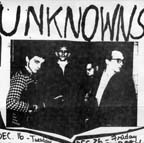 The group had to make some musical adjustments upon moving to San Diego as well. Apart from their originals, their set was heavily beat group oriented. They played the Beatles’ “Please, Please Me” and the Who’s “Substitute”; “My Generation”; and “Our Love Was, Is” from The Who Sell Out. According to Mark, “When we first got to San Diego, we realized that the Crawdaddys had cornered the market on the ‘60s sound. It was pretty depressing because we had been playing Vox amplifiers and doing Beatles and Hollies harmonies.
The group had to make some musical adjustments upon moving to San Diego as well. Apart from their originals, their set was heavily beat group oriented. They played the Beatles’ “Please, Please Me” and the Who’s “Substitute”; “My Generation”; and “Our Love Was, Is” from The Who Sell Out. According to Mark, “When we first got to San Diego, we realized that the Crawdaddys had cornered the market on the ‘60s sound. It was pretty depressing because we had been playing Vox amplifiers and doing Beatles and Hollies harmonies.
We met the Crawdaddys sweeping up after them when they played the Roxy — I thought they were the best band I’d ever seen. But one of the things we noticed was that when they would play — even though it would be brilliant, the best thing you ever saw — people would leave! They’d go and have a smoke, or just stand outside. It would break our hearts because we loved the Crawdaddys, but we knew we had to be careful with that ‘60s element, because a lot of people in the scene were not cool with it. We quit playing covers and focused on original material.”
Mark remembers the moment the Stroke Band was rechristened: “A 6’2” surfer named Clark, our biggest fan, lived down the hall. When we practiced with Joe and Jack, he kept telling us, ‘You guys need a new name.’ So Bruce says, ‘Like what?’ Clark says, ‘Like the Unknowns, man.’ “
At the time, Joe had a crush on Sue Ferguson, the keyboardist in a group called the Mature Adults, which was splitting up. According to Mark, “He told us one day that we were going to try out a keyboard player. Sue showed up about an hour later. She was a sweetheart, a really nice gal who played a ‘60s Fender Contempo organ, but she played only one show with us. She didn’t know the songs very well because we hadn’t practiced much with her, and she had an Ampeg V4 through an Altec 604 monitor — the loudest amplifier any of us had ever heard. It was so loud, it made your teeth hurt!” The Sue Ferguson gig was also the Unknowns’ first show ever, at the Skeleton Club. Shows at the Spirit and the Zebra quickly followed, but the Skeleton Club would become a second home to the band.
To read the rest of the Unknowns' story, purchase Getting Nowhere Fast, Ray Brandes' definitive account of San Diego's music underground from 1976 to 1986.